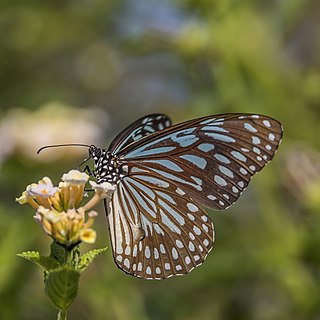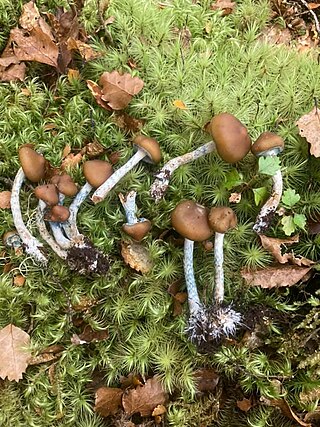
Parantica aglea, the glassy tiger, is a butterfly found in Indomalayan realm that belongs to the crows and tigers, that is, the danaid group of the brush-footed butterflies family.

Tirumala gautama, the scarce blue tiger, is a butterfly species found in India and Southeast Asia that belongs to the "crows and tigers", that is, the danaid group of the brush-footed butterflies family.

Panaeolus olivaceus is a widely distributed, seldom identified, little brown mushroom that contains the hallucinogen psilocybin; it is often mistaken for Panaeolus foenisecii and is distinguished by its black spore print and darker gill coloration when mature alongside a slightly thicker stem. It is even more easily mistaken for Panaeolus cinctulus or Panaeolus fimicola and can be distinguished from them both by its slightly roughened spores. It is also easily confused with Panaeolina castaneifolia, a species which has spores that are dark brown and significantly more roughened.

Psilocybe makarorae is a species of psilocybin mushroom in the family Hymenogastraceae. Officially described as new to science in 1995, it is known only from New Zealand, where it grows on rotting wood and twigs of southern beeches. The fruit body (mushroom) has a brownish cap with lighter coloured margins, measuring up to 3.5 cm (1.4 in) wide. The cap shape is either conical, bell-shaped, or flat depending on the age of the mushroom, and it features a prominent umbo. Although the whitish stem does not form a true ring, it retains remnants of the partial veil that covers and protects the gills of young fruit bodies. P. makarorae mushrooms can be distinguished from the similar North American species Psilocybe caerulipes by microscopic characteristics such as the presence of cystidia on the gill faces (pleurocystidia), and cheilocystidia with more elongated necks. Based on the bluing reaction to injury, P. makarorae is presumed to contain the psychedelic compounds psilocybin and psilocin.

Mycena mustea is a species of mushroom in the family Mycenaceae. First described as a new species in 2007, the fungus is known only from Kanagawa, Japan, where it grows on dead fallen twigs in lowland forests. The mushroom's dull violet to grayish-violet cap, initially covered with a fine whitish powder, becomes smooth as it matures, and eventually reaches a diameter of up to 10 mm (0.39 in). The stem is slender, up to 90 mm (3.5 in) long, and is covered with stiff white hairs at the base. Underneath the cap are distantly spaced pale brownish gills that are narrowly attached to the stem. Microscopic characteristics of the mushroom include the weakly amyloid spores, the club-shaped cheilocystidia featuring one or more short knob-like protuberances, the absence of pleurocystidia, the diverticulate cap cuticle hyphae, and the absence of clamp connections.

Fascellina chromataria is a moth in the family Geometridae described by Francis Walker in 1860. It is found in Korea, Japan, Taiwan, China, India, Bhutan and Sri Lanka.
Allotalanta synclera is a moth in the family Cosmopterigidae. It was described by Edward Meyrick in 1921. It is found in India (Kanara).
Dausara marginalis is a moth in the family Crambidae. It was described by Frederic Moore in 1877. It is found in India and Western New Guinea, Indonesia.
Phostria cleodalis is a moth in the family Crambidae. It was described by William Schaus in 1920. It is found in Bolivia.
Pilocrocis cyranonalis is a moth in the family Crambidae. It was described by William Schaus in 1920. It is found in Guatemala.

Pilocrocis musalis is a moth in the family Crambidae. It was described by Schaus in 1912. It is found in Costa Rica and Panama.
Pilocrocis coptobasis is a species of moth in the family Crambidae. It was described by George Hampson in 1899. It is found in Indonesia and Papua New Guinea, where it has been recorded from the D'Entrecasteaux Islands.
Polygrammodes hyalosticta is a moth in the family Crambidae. It is found in Indonesia, where it has been recorded from the Natuna Islands.
Salbia zena is a moth in the family Crambidae. It was described by Herbert Druce in 1902. It is found in Colombia and Costa Rica.
Sameodes microspilalis is a moth in the family Crambidae. It is found in Zimbabwe.
Syllepte tetrathyralis is a moth in the family Crambidae. It was described by George Hampson in 1912. It is found in New Guinea.
Trichaea nigrans is a moth in the family Crambidae. It was described by Herbert Druce in 1902. It is found in Peru and Bolivia.
Ulopeza denticulalis is a species of moth in the family Crambidae. It was described by George Hampson in 1912. It is found in South Africa.

Morchella arbutiphila is a species of fungus in the family Morchellaceae (Ascomycota), described from the island of Cyprus in 2016. The species is notable for its elongated stipe, which is often longer than the cap's length, its ascospores which are larger than most other species of Morchella, and its highly specific ecological preferences. It is known only from igneous substrates of the Troodos mountains in Cyprus and from a single collection in the Aegean region of Turkey.
Imma nephelatma is a moth in the family Immidae. It was described by Edward Meyrick in 1927. It is found in New Guinea.








